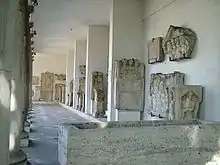
The lapidarium section in the Aquincum Museum, Budapest, Hungary
.JPG.webp)
Lapidarium with epitaphs in the Schottenstift (Scottish Abbey), Vienna
A lapidarium is a place where stone (Latin: lapis) monuments and fragments of archaeological interest are exhibited.[1]
They can include stone epigraphs; statues; architectural elements such as columns, cornices, and acroterions; bas reliefs, tombstones; and sarcophagi.
Such collections are often displayed in the outdoor courtyards of archaeology museums and history museums.
A lapidary museum could either be a lapidarium or – less often – a gem museum (e.g. the Mineral and Lapidary Museum, North Carolina).
Examples
- The Lapidarium (in the National Museum), Prague, Czechia
- The Lapidarium, Kerch, Crimea
- The Lapidarium of Kings, Copenhagen, Denmark
- The Museo lapidario maffeiano (museum-lapidarium of Maffei), Verona, Italy
- The Lapidary Museum, Avignon, France
- The Estense Lapidary Museum, Modena, Italy
- Split Archaeological Museum
See also
- A glyptotheque, a sculpture museum, usually stone sculptures
References
- ↑ Desk, Web (2022-10-02). "Lapidariums: The Rich Tapestry of Historical Artifacts and Culture". Azadi Times. Retrieved 2023-11-02.
External links
 Media related to Lapidariums at Wikimedia Commons
Media related to Lapidariums at Wikimedia Commons
This article is issued from Wikipedia. The text is licensed under Creative Commons - Attribution - Sharealike. Additional terms may apply for the media files.